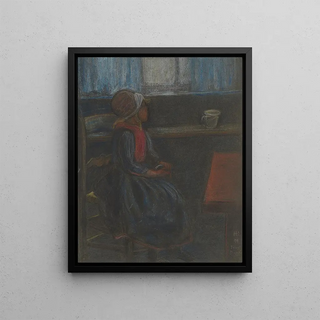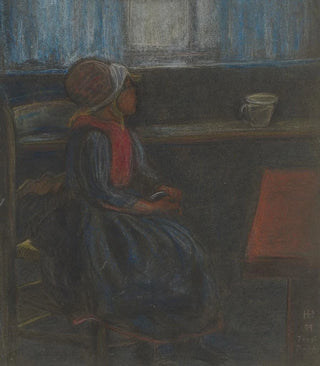Art print | Girl in profile looking out the window to the right - Hermann Lismann


View from behind

Frame (optional)
In the vibrant panorama of 19th-century art, Hermann Lismann's "Girl in profile looking out the window to the right" stands out for its delicacy and emotional depth. This painting, which evokes a palpable intimacy, invites the viewer to immerse themselves in a universe where light plays a leading role. Through this work, Lismann captures a fleeting moment, a contemplative pause, where the young girl appears lost in her thoughts, gazing beyond the surrounding walls. This scene, both simple and meaningful, resonates with timeless beauty, offering a window into the human soul.
Style and uniqueness of the artwork
Lismann's style is characterized by meticulous attention to detail and a subtle use of color. In "Girl in profile looking out the window to the right," the chosen palette evokes a soft, melancholic atmosphere, where each hue contributes to intensifying the scene's emotion. The light, filtering through the window, creates a play of shadows and highlights, accentuating the young girl's face while leaving the rest of the room in semi-darkness. This contrast not only highlights the beauty of the subject but also her isolation. Lismann succeeds in creating a visual dialogue between the interior and exterior, between the inner world of the girl and an outer world that remains inaccessible to her. This duality gives the artwork narrative depth, where each gaze becomes an invitation to explore the heroine's thoughts and dreams.
The artist and his influence
Hermann Lismann, born in an era marked by artistic and social upheavals, knew how to leverage his environment to forge his own style. Influenced by the great masters of painting, he integrated elements of realism while maintaining an intimate and personal approach. Lismann was a keen observer of daily life, and his works often reflect a sharp sensitivity to human emotions. His work, although sometimes little known, has had an impact on his contemporaries and continues to inspire many modern artists. By capturing

Matte finish

View from behind

Frame (optional)
In the vibrant panorama of 19th-century art, Hermann Lismann's "Girl in profile looking out the window to the right" stands out for its delicacy and emotional depth. This painting, which evokes a palpable intimacy, invites the viewer to immerse themselves in a universe where light plays a leading role. Through this work, Lismann captures a fleeting moment, a contemplative pause, where the young girl appears lost in her thoughts, gazing beyond the surrounding walls. This scene, both simple and meaningful, resonates with timeless beauty, offering a window into the human soul.
Style and uniqueness of the artwork
Lismann's style is characterized by meticulous attention to detail and a subtle use of color. In "Girl in profile looking out the window to the right," the chosen palette evokes a soft, melancholic atmosphere, where each hue contributes to intensifying the scene's emotion. The light, filtering through the window, creates a play of shadows and highlights, accentuating the young girl's face while leaving the rest of the room in semi-darkness. This contrast not only highlights the beauty of the subject but also her isolation. Lismann succeeds in creating a visual dialogue between the interior and exterior, between the inner world of the girl and an outer world that remains inaccessible to her. This duality gives the artwork narrative depth, where each gaze becomes an invitation to explore the heroine's thoughts and dreams.
The artist and his influence
Hermann Lismann, born in an era marked by artistic and social upheavals, knew how to leverage his environment to forge his own style. Influenced by the great masters of painting, he integrated elements of realism while maintaining an intimate and personal approach. Lismann was a keen observer of daily life, and his works often reflect a sharp sensitivity to human emotions. His work, although sometimes little known, has had an impact on his contemporaries and continues to inspire many modern artists. By capturing






